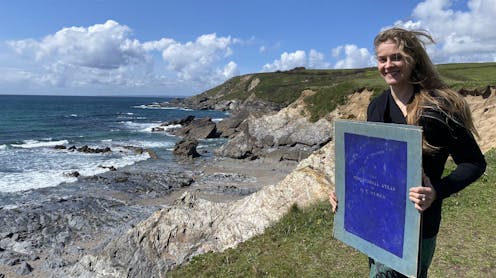
What stands out most about the book I’m carrying under my arm, as I meander through the exhibits at the National Maritime Museum Cornwall in Falmouth, is its awkwardly large size. The Piscatorial Atlas, authored by Ole Theodor Olsen and published in 1883, contains 50 beautifully illustrated charts of the seas around Great Britain. These show the locations exploited at that time for a variety of fish species, alongside the typical vessels or fishing gear used. This information was collated from fishermen in the decade before the atlas was published.
The atlas isn’t a book made for travel. Luckily, it can be readily admired online. But leafing through its carefully curated pages, which contain the collective knowledge of so many people who have long since passed away, feels special, and is why I chose it to show to the programme producers today.
I’ve always loved old books, but I never imagined they would become such an integral part of my work. My interest in marine historical ecology – the use of historical archives to make sense of how our ocean ecosystems are changing – started 18 years ago when I read The Unnatural History of the Sea by Professor Callum Roberts. Within its pages it details how historical perspectives provide critical insights into the deteriorating health of our seas.

Local science, global stories.
This article is part of a series, Secrets of the Sea, exploring how marine scientists are developing climate solutions.
In collaboration with the BBC, Anna Turns travels around the West Country coastline to meet ocean experts making exciting discoveries beneath the waves.
In recent decades, fishery declines, degradation of coastal habitats and the loss of large predators show that exploitation, coastal development, pollution and climate change are exacting their toll on marine ecosystems.
Yet information extracted from old books, reports, and even newspaper articles, show us that many of these issues started long ago. We have exploited the seas for thousands of years, but in Britain, the 19th-century introduction of steam power was a watershed moment. A point in time when our ability to exploit the seas abruptly and dramatically increased. My research aims to uncover how our use of this technological advance – and those that followed – have affected the functioning of marine ecosystems and their continued ability to support our needs.
Transformation of the seas
These negative effects are profound. Towards the end of the Piscatorial Atlas is a page dedicated to the native oyster (Ostrea edulis). It is my favourite of the charts. A gradation of colour indicates where oysters were found in abundance at this time. Colour surrounds the coastal seas of Britain and further afield. Strikingly, there is an enormous area of oyster ground delineated in the southern North Sea.
Today, the native oyster ecosystem is defined as collapsed. The decline of nearshore oyster reefs was well underway by the time the Piscatorial Atlas was published, and the loss of the large North Sea oyster ground – so clear on Olsen’s chart – swiftly followed. As those with the knowledge of these once prolific grounds passed away, the memory of the once vast oyster habitats was lost. This problem was further compounded by science. In the late 19th century, studies of oyster grounds were rare, and scientific surveys almost always occurred after the habitat had been destroyed. Low densities of oysters became the scientific norm.
Recent research I was involved in with a team of experts used historical sources from across Europe to show just how much change has occurred. We showed that reported native oyster habitat once covered tens of thousands of square kilometres and was a dominant feature of some coastal ecosystems. Multiple layers of old oyster shell, consolidated by a layer of living oysters, provided raised reefs that supported a diverse range of species.
The economic and cultural significance of oysters created a more visible historical record than many other species. Yet, the history of marine declines is not limited to oysters. Historical sources quote fishermen concerned about the expansion of trawling and fishing effort. They described the efficiency with which sail trawlers and early steam-powered vessels extracted fish and non-target species from the seafloor.
The impact of land-based activities, such as sediment and pollutant run-off and coastal development, also increased as societies industrialised. These placed marine ecosystems under further pressure, yet regulations governing sustainable management of our seas failed to keep up. These influences, coupled with a collective societal amnesia regarding what we have lost, facilitated the hidden transformation of marine ecosystems.
Using old books and other deep-time approaches, researchers are increasingly making these transformations visible. Reading the words of people from centuries ago, we learn that their experiences of marine ecosystems were often fundamentally different from our own. Understanding the scale of this difference, where species and habitats existed, and in what abundances, can help make the case for their conservation and restoration.
People have always made use of the seas. For me, looking to the past isn’t just about understanding what we have lost, it is also about taking positive lessons from the past, such as the myriad ways in which societies benefited from the presence of healthy marine ecosystems. Heeding these lessons from history helps us visualise the full range of possible futures available to us, including the many benefits that more ambitious conservation and restoration of our ocean ecosystems could bring, should we choose this path.
Listen to episode six of Secrets of the Sea here on BBC Sounds, presented by Anna Turns for The Conversation.
Don’t have time to read about climate change as much as you’d like?
Get a weekly roundup in your inbox instead. Every Wednesday, The Conversation’s environment editor writes Imagine, a short email that goes a little deeper into just one climate issue. Join the 45,000+ readers who’ve subscribed so far.
Ruth H. Thurstan works for The University of Exeter. She receives funding from the Convex Seascape Survey and the European Research Council (ERC) under the European Union’s Horizon 2020 research and innovation programme (grant agreement no. 856488).
This article was originally published on The Conversation. Read the original article.







